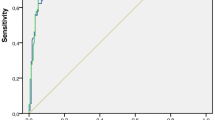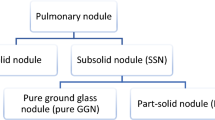Abstract
Purpose
To evaluate whether PET/low-dose CT (ldCT) using 18F-fluorodeoxyglucose (FDG) improves characterization of indeterminate single pulmonary nodules (SPNs) in patients at high risk of lung cancer.
Methods
Retrospective analysis of 307 patients who underwent FDG-PET/CT for indeterminate SPNs identified 93 (70 men, age range 46–90 years) at high risk of lung cancer (age >40 years, minimum 10 pack-year smokers). SPNs were evaluated for the presence and intensity of FDG avidity and ldCT patterns. The performance of visual and semiquantitative FDG-PET/ldCT algorithms for characterization of SPNs was compared to that of ldCT. Incongruent FDG-PET and ldCT patterns were analyzed for significance in further patient management.
Results
Malignancy was diagnosed in 38% patients. FDG avidity defined 33 SPNs as true-positive (TP) and 2 as false-negative (FN) (malignant), and 41 as true-negative (TN) and 17 as false-positive (FP) (benign). For SUVmax of 2.2 (by ROC analysis) there were 27 TP, 8 FN, 48 TN and 10 FP SPNs. LdCT defined 34 TP, 1 FN, 28 TN and 30 FP lesions. Of the FP lesions on ldCT, 60% were FDG-negative. Visual PET/ldCT analysis had a sensitivity of 94%, a specificity of 70%, an accuracy of 80%, a positive predictive value (PPV) of 66%, and a negative predictive value (NPV) of 95% as compared to 77%, 83%, 81%, 73%, 86% for semiquantitative PET/ldCT and 97%, 48%, 66%, 53%, 96% for ldCT, respectively. Both PET/ldCT algorithms had statistically significantly higher specificity and accuracy than ldCT. Semiquantitative analysis showed significantly higher PPV and lower sensitivity and NPV than found with ldCT.
Conclusion
A single screening procedure encompassing FDG-PET and ldCT may improve screening for lung cancer in high-risk patients. The significantly improved specificity may potentially reduce FP ldCT results and further unnecessary invasive procedures.





Similar content being viewed by others
References
Ost D, Fein AM, Feinsilver SH. Clinical practice: the solitary pulmonary nodule. N Engl J Med 2003;348:2535–42.
Mack MJ, Hazelrigg SR, Landreneau RJ, Acuff TE. Thoracoscopy for the diagnosis of the indeterminate solitary pulmonary nodule. Ann Thorac Surg 1993;56:825–30.
Ray JF 3rd, Lawton BR, Magnin GE, Dovenbarger WV, Smullen WA, Reyes CN, et al. The coin lesion story: update 1976: twenty years’ experience with early thoracotomy for 179 suspected malignant coin lesions. Chest 1976;70:332–6.
MacMahon H, Austin JH, Gamsu G, Herold CJ, Jett JR, Naidich DP, et al. Guidelines for management of small pulmonary nodules detected on CT scans: a statement from the Fleischner Society. Radiology 2005;237:395–400.
Mulshine JL. Screening for lung cancer: in pursuit of pre-metastatic disease. Nat Rev Cancer 2003;3:65–73.
Schottenfeld D. Etiology and epidemiology of lung cancer. In: Pass HI, Mitchell JB, Johnson DH, Turrissi AT. editors. Lung cancer: principles and practice. Philadelphia: Lippincott Williams and Wilkins; 2000. p. 367–88.
Jemal A, Murray T, Samuels A, Ghafoor A, Ward E, Thun MJ. Cancer statistics, 2003. CA Cancer J Clin 2003;53:5–26.
Flehinger BJ, Melamed MR, Zaman MB, Heelan RT, Perchick WB, Martini N. Early lung cancer detection: results of the initial (prevalence) radiologic and cytologic screening in the Memorial-Sloan Kettering study. Am Rev Respir Dis 1984;130:555–60.
Fontana RS, Sanderson DR, Taylor WF, Woolner LB, Miller WE, Muhm JR, et al. Early lung cancer detection: results of the initial (prevalence) radiologic and cytologic screening in the Mayo Clinic study. Am Rev Respir Dis 1984;130:561–5.
Fontana RS, Sanderson DR, Woolner LB, Taylor WF, Miller WE, Muhm JR. Lung cancer screening: the Mayo program. J Occup Med 1986;28:746–50.
Henschke CI, McCauley DI, Yankelevitz DF, Naidich DP, McGuinness G, Miettinen OS, et al. Early Lung Cancer Action Project: overall design and findings from baseline screening. Lancet 1999;354:99–105.
Bastarrika G, Garcia-Velloso MJ, Lozano MD, Montes U. Early lung cancer detection using spiral computed tomography and positron emission tomography. Am J Respir Crit Care Med 2005;171:1378–83.
Lowe VJ, Fletcher JW, Gobar L, Lawson M, Kirchner P, Valk P, et al. Prospective investigation of positron emission tomography in lung nodules. J Clin Oncol 1998;16:1075–84.
Gould MK, Maclean CC, Kuschner WG, Rydzak CE, Owens DK. Accuracy of positron emission tomography for diagnosis of pulmonary nodules and mass lesions; a meta-analysis. JAMA 2001;285:914–24.
Bar-Shalom R, Yefremov N, Guralnik L, Gaitini D, Frenkel A, Kuten A, et al. Clinical performance of PET/CT in evaluation of cancer: additional value for diagnostic imaging and patient management. J Nucl Med 2003;44:1200–9.
Lardinois D, Weder W, Hany TF, Kamel EM, Korom S, Seifert B, et al. Staging of non-small-cell lung cancer with integrated positron-emission tomography and computed tomography. N Engl J Med 2003;348:2500–7.
Lindell RM, Hartman TE, Swensen SJ, Jett JR, Midthun DE, Nathan MA, et al. Lung cancer screening experience: a retrospective review of PET in 22 non-small cell lung carcinomas detected on screening chest CT in a high-risk population. AJR Am J Roentgenol 2005;185:126–31.
Caskey CI, Templeton PA, Zerhouni EA. Current evaluation of the solitary pulmonary nodule. Radiol Clin North Am 1990;28:511–20.
Erasmus JJ, Connolly JE, McAdams HP, Roggli VL. Solitary pulmonary nodules: Part I Morphologic evaluation for differentiation of benign and malignant lesions. Radiographics 2000;20:43–58.
Shaham D, Guralnik L. The solitary pulmonary nodule: radiologic considerations. Semin Ultrasound CT MR 2000;21:97–115.
American Cancer Society. Cancer facts and figures: statistics, 2005. Atlanta: American Cancer Society, 2005.
Flehinger BJ, Kimmel M, Melamed MR. Survival from early lung cancer: implication for screening. Chest 1992;101:1013–8.
Melamed MR, Fleihinger BJ, Zaman MB. Impact of early detection on the clinical course of lung cancer. Surg Clin North Am 1987;67:909–24.
Nesbitt JC, Putnam JB Jr, Walsh GI, Roth JA, Mountain CF. Survival in early-stage lung cancer. Ann Thorac Surg 1995;60:466–72.
Shah R, Sabanathan S, Richardson J, Means AJ, Goulden C. Results of surgical treatment of stage I or II lung cancer. J Cardiovasc Surg 1996;37:169–72.
Sobue T, Suzuki T, Matsuda M, Kuroishi T, Ikeda S, Naruke T. Survival for clinical stage I lung cancer not surgically treated. Cancer 1992;69:685–92.
Bury T, Dowlati A, Paulus P, Corhay JL, Benoit T, Kayembe JM, et al. Evaluation of the solitary pulmonary nodule by positron emission tomography imaging. Eur Respir J 1996;9:410–4.
Kim SK, Allen-Auerbach M, Goldin J, Fueger BJ, Dahlbom M, Brown M, et al. Accuracy of PET/CT in characterization of solitary pulmonary lesions. J Nucl Med 2007;48:214–20.
Brix G, Lechel U, Glatting G, Ziegler SI, Münzing W, Müller SP, et al. Radiation exposure of patients undergoing whole-body dual-modality 18F-FDG PET/CT examinations. J Nucl Med 2005;46:608–13.
Jakoby BW, Townsend DW, Sibomana M, et al. A large volume PET scanner for low dose applications. IEEE Nuclear Science Symposium Conference Record 2006, vol. 5, p. 3100–1.
Jakoby BW, Bercier Y, Watson CC, et al. Physical performance and clinical workflow of a new LSO HI-REZ PET/CT scanner. IEEE Nuclear Science Symposium Conference Record 2006, vol. 5, p. 3130–4.
Panin VY, Kehren F, Michel C, Casey M. Fully 3-D PET reconstruction with system matrix derived from point source measurements. IEEE Trans Med Imaging 2006;25:907–21.
Acknowledgments
The authors express their gratitude to Drs. Einat Even-Sapir and Ada Tamir for critical review of the paper and their many useful suggestions.
Author information
Authors and Affiliations
Corresponding author
Rights and permissions
About this article
Cite this article
Kagna, O., Solomonov, A., Keidar, Z. et al. The value of FDG-PET/CT in assessing single pulmonary nodules in patients at high risk of lung cancer. Eur J Nucl Med Mol Imaging 36, 997–1004 (2009). https://doi.org/10.1007/s00259-009-1061-9
Received:
Accepted:
Published:
Issue Date:
DOI: https://doi.org/10.1007/s00259-009-1061-9




